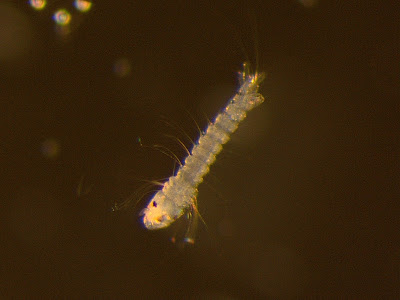This week's case was made possible by BEI Resources and the NIH-NIAID Filariasis Research Reagent Resource (FR3) Center. They provided the materials and excellent instructions for this special experiment:
These black elliptical objects measure ~550-600 micrometers long, and came dried on a piece of paper towel. I added a strip of the paper towel to a Petri dish containing distilled water and waited about 30 minutes for the action to start. Here is what happened:
Here are some still shots of the action:
What are these objects??



Aedes eggs and larvae?
ReplyDeletemosquito larvae
ReplyDeleteBW from Vt
For sure those are mosquito eggs, they stick together like rafts on top of the water. The wigging larva hatches from one of these eggs. I would leave the mosquito identification to entomologists, as a kid I used to scoop the larvae with a small net to feed my Siamese beta fighters.
ReplyDeleteFlorida Fan
Can't ID at 1st instar, but I'm guessing these are Aedes aegypti given the source :)
ReplyDeleteThank you for showcasing the FR3, Bobbi!!
Mosquito larvae and eggs :)
ReplyDeleteThank you Bobbi! The FR3 is always available for filariasis research and teaching needs!
ReplyDeleteIt definitely belongs to the Culicidae family. Taking into account the shape/color and chorionic sculpture of the eggs, as well as the shape of the larva's head and thorax and the presence of a pronounced siphon in the terminal position of the abdomen, I think it is Aedes sp.
ReplyDeleteAwesone
ReplyDeleteDefinitely Culicidae eggs and larvae. Anopheline eggs have this "hot-dog" appearance.
ReplyDeleteFor the precise ID, it's probably Aedes spp. if we judge by the bulky and short respiratory siphon on the close-up picture of a larva (Culex spp. have a longer and thinner siphon).